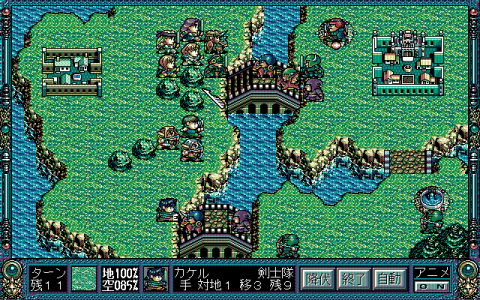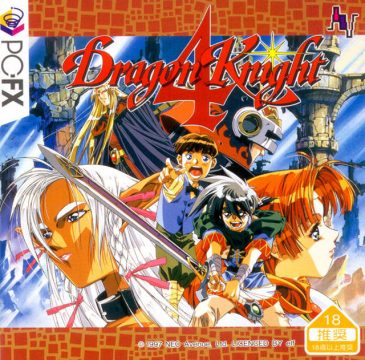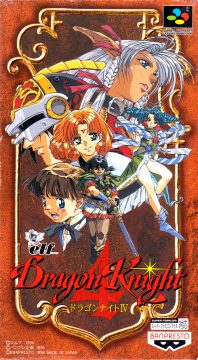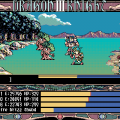The story starts in a distant future, in another dimension. Lucifon, one of the great four generals of the demon world, has been having an affair with Mano, the daughter of the demon world king. This fact eventually reaches her father’s ears, and after confronting Lucifon with it, the king decides to ban him to a space between dimensions all alone as punishment. After an immeasurable amount of time has passed, the king talks to Lucifon again and gives him a mission: To go back in time and kill Takeru, as he was the main reason the demons stopped being able to influence the human world. The king also guarantees that he will approve Lucifon’s relationship with Mano should he succeed. Lucifon accepts the mission and goes back in time to when Takeru was still alive.
Back in that age, Takeru and Luna live a happy and quiet live, and their son, Kakeru, grows up to be a brave and energetic young boy, though also a bit of a pervert, just like his father. It is after Kakeru turns 15 years old that a letter arrives to their house. Baan is asking for Takeru’s help in some kind of trouble, but Takeru decides to send his son instead, as he’s certain there is no danger now that they live in a world with no monsters or demons. Kakeru happily embarks on his journey, unaware of what awaits him…
Characters

Kakeru
Takeru’s son and the main protagonist. He’s brimming with curiosity, and fear is a concept unknown to him. Voiced by Megumi Ogata in the PC-FX and PlayStation versions.

Natasha
Kakeru’s childhood friend and an apprentice magician. She goes after Kakeru when he leaves the village on his journey. Voiced by Saori Sugimoto in the PC-FX and PlayStation versions.
Seiru
Baan’s son. Unlike Kakeru, he doesn’t take after his father. He’s a scaredy-cat and doesn’t want to leave his village to help Kakeru, but Baan forces him to go anyway. Voiced by Chisato Nakajima in the PC-FX and PlayStation versions.
Eto
A mysterious man that suddenly shows up and helps Kakeru and Seiru. No one has ever seen him without his mask, and the only thing he reveals about himself is his name. Voiced by Ryotaro Akiyuki in the PC-FX and PlayStation versions.
Marlene
A survivor of an elf village destroyed by Lucifon’s army. She joins Kakeru and his friends and vows to take revenge. Voiced by Yumi Toma in the PC-FX version and Michiko Neya in the PlayStation version.
Lucifon
The main antagonist. He goes back in time to kill Takeru, not expecting it would be Kakeru who would confront him. Voiced by Toshikazu Shiozawa in the PC-FX and PlayStation versions.
Dragon Knight 4 is a SRPG with some heavy influence from games like Fire Emblem and Nintendo Wars. Battles are fought on hexagonal grids, and the main objective is always to reach the next town or defeat all enemies. Rushing to the town is usually not a good idea, as the enemies will gang up on your weakest characters and kill them in no time. And if characters are killed in battle, they are permanently gone. Getting one of the five main characters killed will also result in an instant game over, so carefully positioning your characters is of utmost importance. Each character has their own class, ranging from swordsmen to magicians, and even the titular dragon knights. For the most part, these just determine the number of steps a unit can take in a turn and how far they can attack, but in the case of dragon knights, it also affects who can attack them, as they are flying units.
Instead of having HP for units, the game uses a system similar to the Nintendo Wars games, where each unit is defined as a number of soldiers. Soldiers get killed each time a unit is attacked, and the number remaining influences their strength and defense, so whoever attacks first has always the advantage. Even the most powerful units will become useless after taking a few attacks, which is where healing comes in. Most maps have two or three healing points scattered around, where you can station your units so that they start the next turn fully healed, but enemies are also able to take advantage of these. To prevent players from abusing them with hit and run strategies, the game introduces a turn limit system, and battles will instantly end with a game over if the turn limit is reached. The game has a nice balance of preventing players from rushing to end the battles quickly, but also forcing them to take a few risks to finish within the turn limit. Most of the challenge and fun in the game comes from trying to finish each map with every character alive, as simply winning usually isn’t that hard.
Killing enemies in battle is the main way to make your characters stronger. There is no level up system, so instead of experience points, they will just give you a number of attack and defense points, depending on how strong the enemy killed was. The other way is finding attack and defense seeds, and each map has them scattered around in unknown positions. When a character lands in a position with one of these seeds, his attack/defense points will automatically go up. There are also seeds for increasing your movement and attack range, but those are rare – less than ten exist in the whole game. Since there is no way of knowing where seeds are, most of them end up being picked at random in the first playthrough.
Between each battle, there are town exploration parts where most of the story plays out. All of the characters in your army show up in town as interactive NPCs, with all sorts of fun dialogue and situations prepared for each one. This is one of the main reasons you won’t want to let any of the characters die in battle, as they all have their own unique lines in each town, and some even have relationships with other characters. One example of this is Rosalind, one of the recruitable characters who eventually falls in love with Seiru, if she stays alive long enough. Recruiting characters is also done in towns, usually giving the choice between a female and male one. Of course, this being an erotic game for a male audience, the female characters have a lot more scenes than the male ones. It’s not possible to have every recruitable character in the army in one playthrough, so multiple playthroughs are necessary in order to see every event in the game. Another thing to do in towns is exploring for hidden seeds, which can be stocked and used in any of the available units, a good way to train weak characters. Each town has always a number of important story scenes the player must see before proceeding to the next battle.
Dragon Knight 4 (PC-98)
And the story is one of the best things about Dragon Knight 4, and the main reason fans loved it and consider it a classic in the genre. While the first three games were light on plot, this one has a script several times bigger and one of the most satisfying stories in a Japanese RPG at the time. It’s not the most original story around, but some of the plot devices used were unusual back then, and it all comes together really well thanks to the great character development and writing. The feeling of a long journey across the world and the impending doom as it comes closer and closer to the end is done surprisingly well, and by the time the characters arrive at the last town, there’s a great feeling of hopelessness and doubt that the protagonists can succeed. One of the best elements is also the growth of Kakeru, Seiru and Natasha, as they are all teenagers that got involved in something way too big for them. Not everything is perfect though, as there are some problems and plot threads left without conclusion by the time the game ends.
But what really brings the characters and story to life is the wonderful presentation. Since the artists from the previous games were already gone from Elf, Masaki Takei, who previously worked as an animator for the Madhouse studio, joined the team as the main artist for the fourth game. Takei was on a whole different level than the previous artists, partly thanks to his experience in the anime industry, and he put together some really beautiful drawings for the game, even going through the trouble of animating a few of them. There are more than two hundred unique pieces of art used throughout the whole game to complement each scene, and the graphics team did a fantastic job at rendering Takei’s art on a computer screen.
At the time of release, buyers of the game could request the Dragon Knight 4 Special Disk from Elf. This included extras like a quiz game, new modes where you could look at the art and listen to the music from the game, a hint corner for people stuck in the main game, and some staff comments and even unused art.
Dragon Knight 4 is a great example of an erotic game that is actually good, and one that a lot of SRPG fans would most likely enjoy. Sadly, despite being generally considered the best game in the series, it never got the sales from the first games. By the time it was released, pure dating sims and visual novels were all the rage, and Elf fans just wanted a sequel to their groundbreaking success Doukyuusei more than anything. But Elf games were still a huge property, and Dragon Knight a big name, so two companies showed interest in porting it for home consoles: Banpresto and NEC Avenue. Banpresto developed two different versions at the same time, one for the Super Famicom and the other for the PlayStation, while NEC Avenue developed a version for the ill-fated PC-FX. These were all released around the beginning of 1997, just a few months apart from each other.
Dragon Knight 4 (PC-98)
The Super Famicom version tries to be faithful to the original for the most part, other than changing one part of the journey due to censoring. The battle maps and system are mostly unchanged, but it adds experience points and a level-up system. Exclusive to this version is the resurrection seed, an item that lets you revive one of your dead characters, which makes it the easiest version of the game. Banpresto also added a new recruitable character, Wendy, and the new enemy characters Ridya, Hadess and Beirit. Due to the Super Famicom limitations, it removes a good part of the art from the original, and what remains is displayed at a much lower resolution. To compensate, the towns probably look the best in this version, with some good quality sprite work and a more visually pleasing color palette than any other version.
For the PlayStation, Banpresto decided to change things a bit more, transforming it into a much harder game, one that requires more strategy and careful planning. The battle maps are all different, the turn limit is less lenient, and the enemy units are stronger. Wendy from the SFC version is gone and replaced with another character, Sara. There are newly added voices for the characters, but not a lot of scenes are voiced, and most of the lines remain silent. For the towns, there is a new dating system unique to this version, where the player is able to call a girl and talk to her and improve relationship points depending on the chosen answers. This doesn’t affect anything in the story other than some minor differences in the ending, and is mostly pointless. Some of the music has also been changed, and most tracks don’t sound as good as the originals.
NEC Avenue’s PC-FX was released last, and it’s the most faithful of the three. Compared to the Super Famicom and PlayStation ports, there’s a lot less censoring, and the sex scenes are pretty much the only parts of the story that were removed. The battles and towns remain unchanged, although it suffers from keeping the same town designs with a reduced resolution, so exploring them is a bit more annoying as you can’t see a lot around you. Just like the previous PC Engine ports, voice acting was the main focus in this one, and there are a lot more voiced scenes than in the PlayStation version, all with incredibly popular voice actors, including Megumi Ogata, the voice of Shinji from Neon Genesis Evangelion.
Thirteen years after the original release, Elf decided to remake Dragon Knight 4 for Windows. The story remains completely unchanged, and even all the original art is used again, but the game system was remade from scratch. It ditches the hexagonal maps, going for the classic square grid instead, uses HP and a level-up system, and each character now has a lot more attributes other than strength and defense. There are also skills in addition to normal attacks, and the direction a character is facing when attacked influences his defense power. A selection of three default difficult settings was added, with an extra Challenge mode becoming available after completing the game. While the remake sounds good on paper, the cheap 3D graphics, annoying controls, and inferior renditions of the music make it one of the least fun versions to play, and is only a good alternative if you can’t play the original computer versions and want the uncensored story.
Comparison Screenshots – Introduction
Comparison Screenshots – Town
Comparison Screenshots – Town Conversation
Comparison Screenshots – Event Scene
Comparison Screenshots – Battle Map
Comparison Screenshots – Battle Animation
Cameos
Elf All Stars Datsui Jan 3
The Dragon Knight 4 characters appear in Elf All Stars Datsui Jan 3, a strip mahjong game featuring characters from various Elf games, released in 2006.
Conclusion
Although Dragon Knight 4 ends with a “To be continued” screen and there are some parts of the story that suggest there were plans for at least one more sequel, there’s barely any hope of one ever surfacing. Elf has lost almost all of their employees in recent years, who decided to form a new company called Silky’s Plus, and Hiruta also left the company in the early 2000s, with no one really knowing what he has been up to since then. One popular theory is that Doten Meikai, the only writer who still remains at Elf, is actually Hiruta himself, but there’s no proof to support these claims.
Before leaving the company, he did try to release a remake/reboot of the original Dragon Knight for the Saturn, but Sega stopped allowing games with nudity on the console, which made Elf cancel the project. Some of the designs created for it would later resurface in the Windows version of Words Worth, another Elf dungeon crawler.
Links:
Elf Elf’s homepage (NSFW)
Dragon Knight 4 The official homepage for the 2007 Windows remake (NSFW)
Retro Game Report Includes full playthroughs for all the original versions of the four games. In Japanese. (NSFW)
The Rise and Fall of Elf An account on the history of Elf from someone that followed them throughout the years. In Japanese.
Elf in the Old Days A video showing the Elf offices back when they were making Dragon Knight II. In Japanese.




